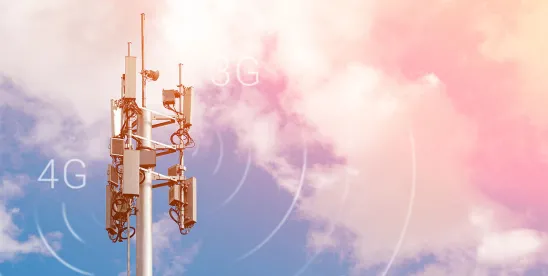The next-generation of wireless technologies – known as 5G – is here. Not only is it expected to offer network speeds that are up to 100 times faster than 4G LTE and reduce latency to nearly zero, it will allow networks to handle 100 times the number of connected devices, revolutionizing business and consumer connectivity and enabling the “Internet of Things.” Leading policymakers – federal regulators and legislators – are making it a top priority to ensure that the wireless industry has the tools it needs to maintain U.S. leadership in commercial 5G deployments. This blog provides monthly updates on FCC actions and Congressional efforts to win the race to 5G.
Regulatory Actions and Initiatives
COVID-19 Relief
-
The FCC continues to assist wireless service providers ease the strain on their networks during the COVID-19 pandemic.
-
On February 19, 2021, the FCC made publicly available several earlier grants of emergency requests to operate on unassigned 2.5 GHz spectrum during the COVID-19 pandemic to the Hoopa Valley Public Utilities District, the Crow Creek Sioux Tribe, the Lower Brule Sioux Tribe, the Santa Clara Pueblo, and United Wireless.
-
The FCC also released a copy of its earlier grant of special temporary authority to T-Mobile to use 600 MHz spectrum licensed to DISH to provide improved and expanded wireless service to consumers as well as facilitate the rapid deployment of its 5G network during the pandemic.
-
Mid-Band Spectrum
-
The FCC grants additional applications for Tribal entities to use spectrum in the 2.5 GHz band.
-
On February 24, 2021, the FCC announced that an additional 21 applications filed in the Tribal Priority Window for licenses in the 2.5 GHz band have been granted. It noted that, to date, the FCC has granted 205 licenses in the 2.5 GHz band to help address rural Tribal connectivity needs.
-
In addition, on March 1, 2021, the FCC released an Order granting three separate requests for waiver filed by the Santa Ynez Band of Chumash Mission Indians regarding the definition of eligible Tribal lands for purposes of the 2.5 GHz Rural Tribal Priority Window. Grant of the Tribe’s waiver requests will allow it to obtain licenses for non-reservation trust and Tribally-owned fee lands nearby or adjacent to its reservation in California.
-
-
The FCC plans to adopt rules that would make spectrum in the 3.45-3.55 GHz band available for commercial services and seek input on an auction of that spectrum.
-
On February 24, 2021, the FCC released a draft Order that would, if adopted at the FCC’s next open meeting on March 17, 2021, make 100 megahertz of spectrum in the 3.45-3.55 GHz band available for full-power commercial wireless services across the contiguous United States, while also ensuring that existing federal users can have access to the spectrum on a protected basis where and when they need it.
-
The FCC also released a draft Public Notice that would, if adopted, seek comment on the procedures it would use for the auction of the 3.45-3.55 GHz band and would propose to commence bidding on October 5, 2021, consistent with its statutory objective to auction the spectrum by December 31, 2021.
-
-
Assignment phase bidding in the C-band auction – the FCC’s largest auction of mid-band spectrum for 5G services – concludes.
-
On February 24, 2021, the FCC released a Public Notice announcing that bidding in the second phase (or assignment phase) of the auction for spectrum in the 3.7-4.2 GHz band, known as the C-band, where bidders may bid on specific frequencies, concluded on February 17, 2021. It also issued a News Release listing the five bidders with the largest total gross winning bid amounts and largest number of licenses.
-
FCC Commissioner Carr released a statement on the close of the C-band auction, noting that “[t]he successful close of bidding in the C-Band auction notches another win for U.S. leadership in 5G by delivering 280 MHz of the prime, mid-band spectrum needed to power high-speed Internet services.” He also urged the FCC to “build on this success by moving quickly with additional 5G auctions, including by moving forward this year with auctions in the 2.5 GHz and 3.45 GHz bands” in order to “further secure U.S. leadership in 5G.”
-
5G Funding
-
The FCC creates a Task Force to develop maps that will, among other things, help determine which areas should receive support to deploy 5G services.
-
On February 17, 2021, Acting FCC Chairwoman Rosenworcel announced the establishment of a Broadband Data Task Force to collect detailed data and develop more precise maps about broadband availability in the U.S. The maps will be used to inform the FCC’s efforts to close the digital divide, including its 5G Fund, which will make available up to $9 billion in federal subsidies over 10 years to bring voice and 5G broadband services to unserved rural areas.
-
5G Networks and Infrastructure
-
NIST requests public input on proposed guidance to address 5G network cybersecurity risks.
-
The National Institute of Standards and Technology (“NIST”) released a preliminary draft guide on how operators and users of 5G networks can mitigate 5G cybersecurity risks. NIST expects the draft practice guide to be the first of three volumes on 5G cybersecurity. Comments on the preliminary draft are due March 4, 2021.
-
-
The FCC is poised to solicit feedback on Open RAN networks.
-
On February 24, 2021, the FCC released a draft Notice of Inquiry (“NOI”) that would, if adopted at its March 17, 2021 open meeting, seek input on the current status and deployment of Open Radio Access Networks (“Open RAN”), which some parties assert are a potential path to drive 5G innovation, and virtualized network environments, domestically and internationally. The NOI would ask how Open RAN networks help further the FCC’s goals and Congressional efforts to promote secure communications networks and help bring broadband to millions of Americans. The NOI would also seek comment on any barriers to Open RAN development and deployment and the costs and benefits of Open RAN deployment. The FCC has not yet provided comment deadlines for the NOI.
-
Other Spectrum Issues
-
The FCC enters into an agreement with other agencies to support spectrum innovation and maximize use.
-
On February 1, 2021, the FCC announced that it entered into an agreement with the National Science Foundation (“NSF”) and National Telecommunications and Information Administration (“NTIA”) “to support NSF’s Spectrum Innovation Initiative,” which was launched last year to support research and development activities to maximize spectrum use and resources. It notes that “[k]ey research areas include spectrum flexibility and agility, working towards near real-time spectrum awareness, and improved spectrum efficiency and effectiveness through secure and autonomous spectrum decision-making” and that “[t]he first key goal will be establishing the U.S.’s first National Center for Wireless Spectrum Research.”
-
A copy of the agreement was released on March 1, 2021, and is available here. According to a post from NTIA, the agreement “facilitates expert staff from the FCC and NTIA, including the Office of Spectrum Management and the Institute for Telecommunication Sciences, sharing their expertise to help ensure that NSF investments in spectrum research, infrastructure, and workforce development align with U.S. spectrum regulatory and policy objectives, principles, and strategies.”
-
-
NTIA releases a paper on sharing of spectrum used by federal entities.
-
On February 22, 2021, NTIA released a paper on the use of an Incumbent Informing Capability (“IIC”) for time-based sharing of federal spectrum. It notes that an IIC mechanism is more reliable for new entrants and for the protection of federal incumbents than existing mechanisms. The paper provides information on the operational needs of federal incumbents and the “business processes” that must be established to safeguard those operations while allowing new entrants to share the spectrum, consistent with NTIA and FCC regulations. Finally, it observes that NTIA’s vision for the IIC is that it evolves to become a “uniform standardized platform” for spectrum sharing across multiple bands, and NTIA expects that it will be deployed over the next few years to support mid-band sharing.
-
Legislative Efforts
-
Several bills were reintroduced in the House that would promote and streamline broadband infrastructure deployment.
-
On February 16, 2021, Republican members of the House Energy and Commerce Committee released a comprehensive package of 28 bills to promote new infrastructure deployment, promote collocation and modifications to existing infrastructure for competition and consumer choice, remove unnecessary or duplicative barriers from environmental and historical reviews, and promote broadband deployment on federal lands.
-
-
A bill was reintroduced in the House that would require the FCC to determine the amount of spectrum needed to support the continued growth of IoT and 5G devices.
-
On February 2, 2021, Representatives DelBene and Katko reintroduced the Internet of Things Readiness Act of 2021. If enacted, the bill would require the FCC to collect and maintain data on the growth of the use of Internet of Things (“IoT”) and 5G-enabled devices in order to determine the amount of spectrum that these devices need. It would also require the FCC to biennially report to Congress on its data collection.
-
-
A bill was reintroduced in the Senate to address the need for a trained telecommunications workforce to meet the demands of 5G.
-
On February 2, 2021, Senator Thune and members of the Senate Commerce Committee introduced the Telecommunications Skilled Workforce Act. The bill would require the Department of Labor, in consultation with the FCC, to establish an interagency working group that would provide recommendations to Congress on the workforce needs of the telecommunications industry. It would also require the Department of Labor, in consultation with the FCC, to issue guidance to States on how to use federal resources to address workforce needs and to promote and improve recruitment in workforce development programs. The bill would further direct the Government Accountability Office to conduct a study to determine the number of skilled telecommunications workers needed to build and maintain broadband infrastructure in rural areas and the 5G wireless infrastructure needed for 5G wireless technology. In a News Release, Commissioner Carr, who leads a 5G jobs initiative, stated that completing the 5G build in the U.S. will require “double the number of skilled tower techs and telecom crews.” He praised the Senators for introducing the bill, which would “create thousands of good-paying jobs.”
-








 />i
/>i

